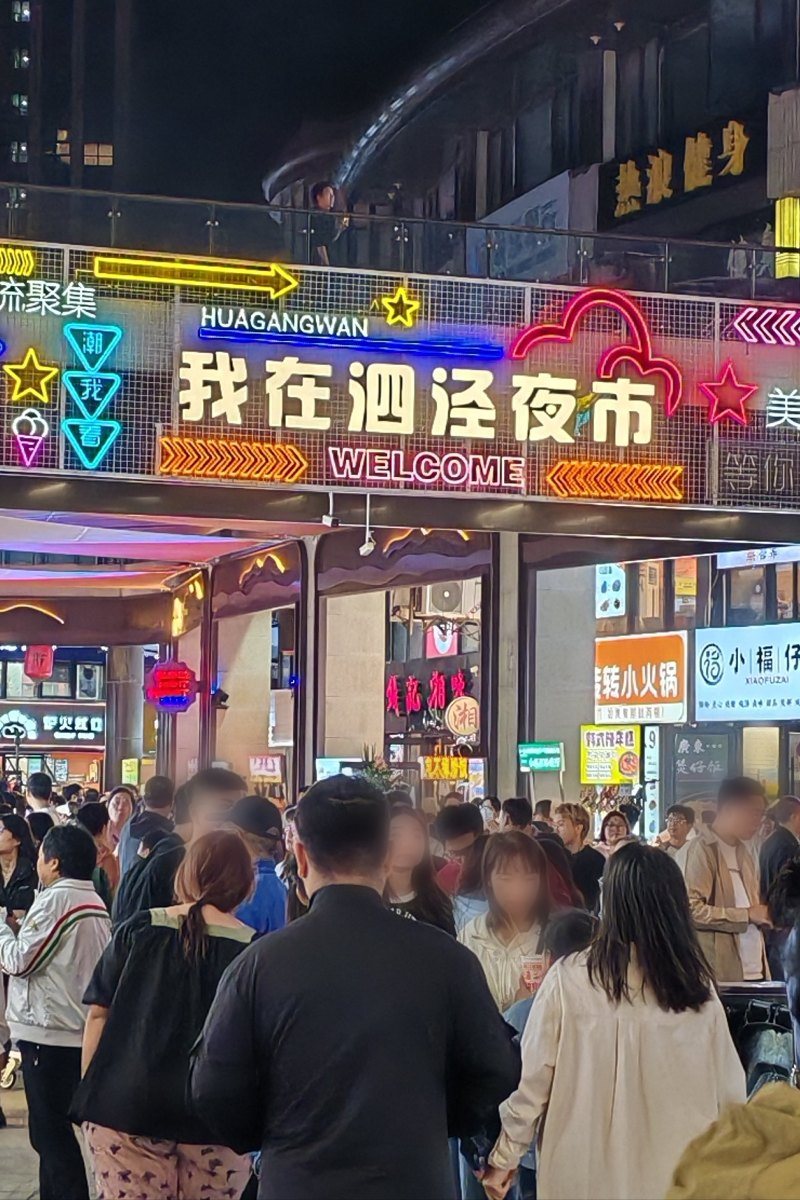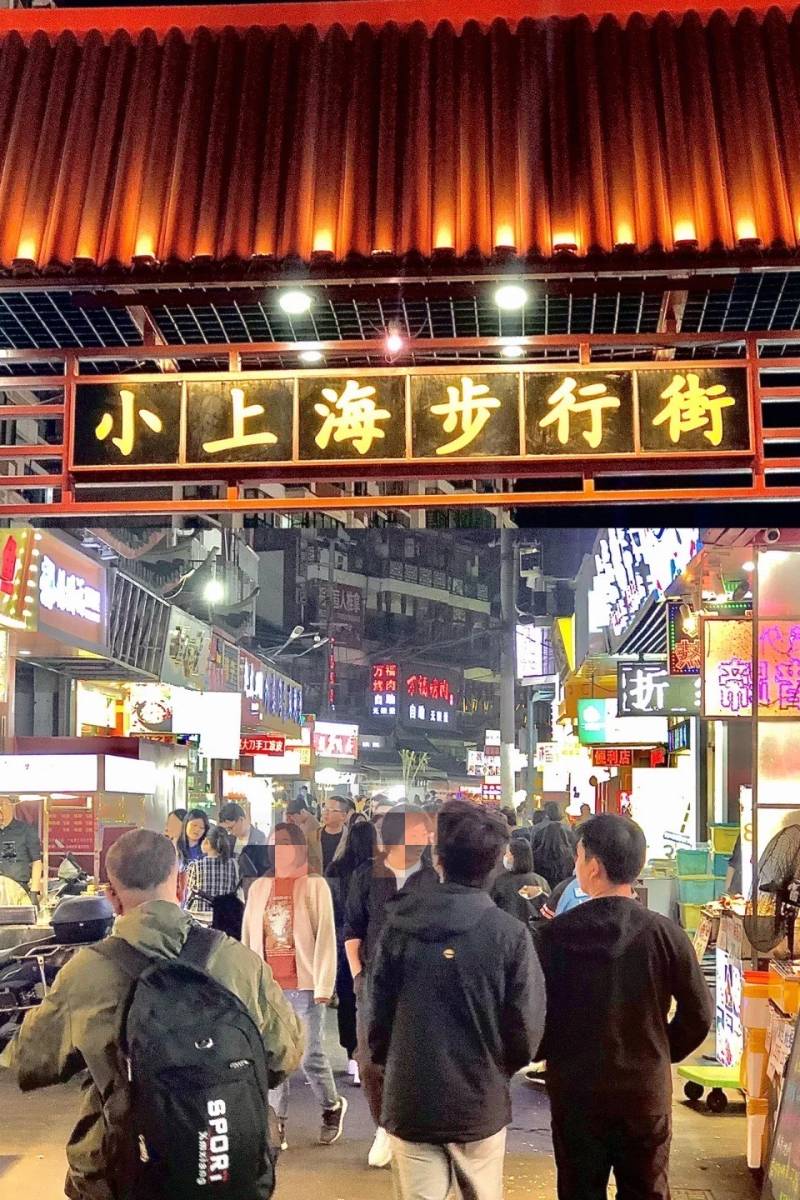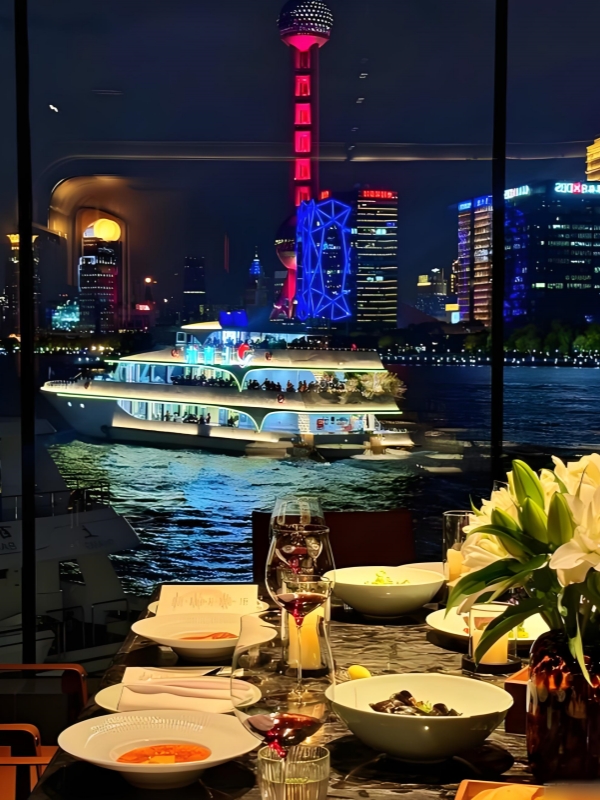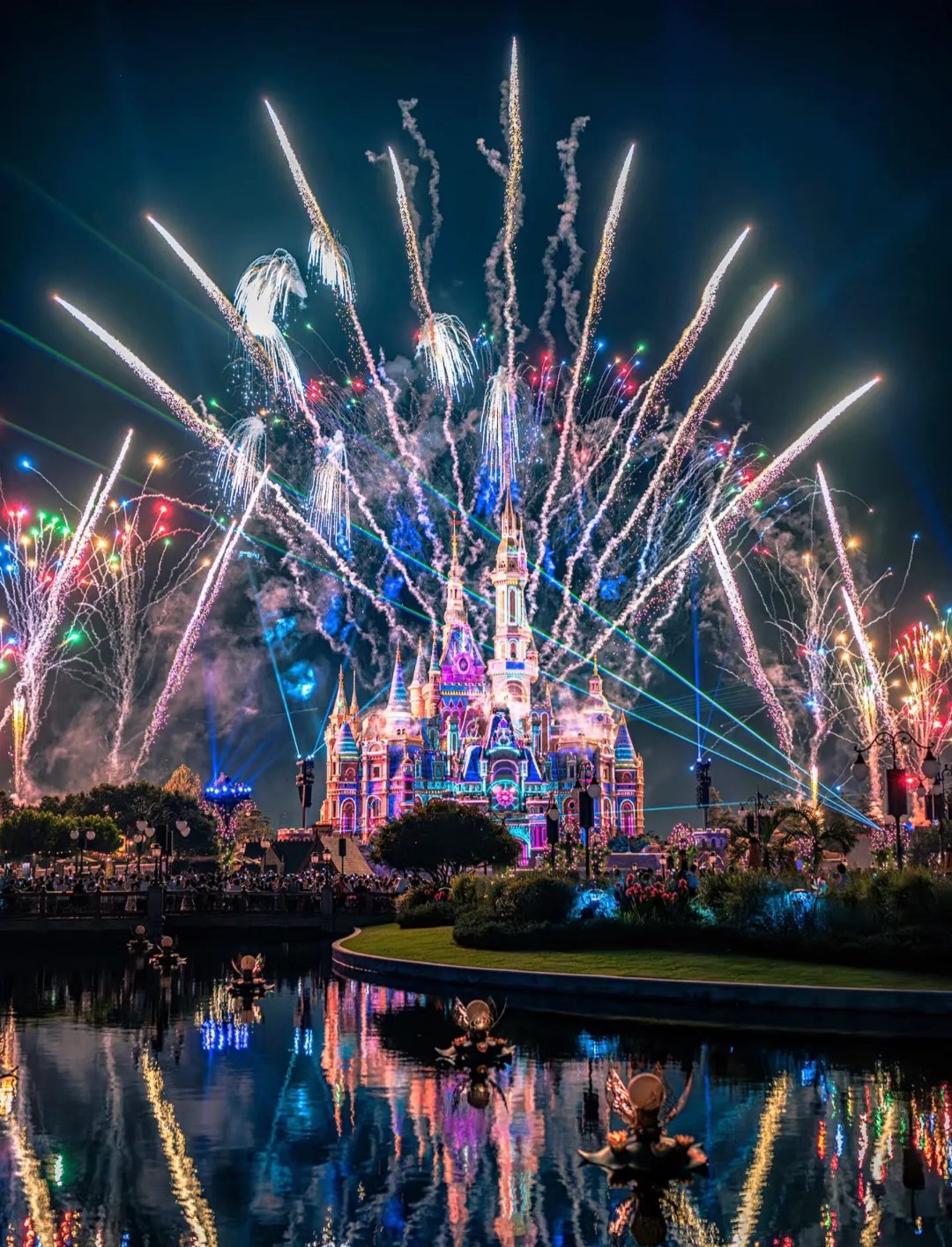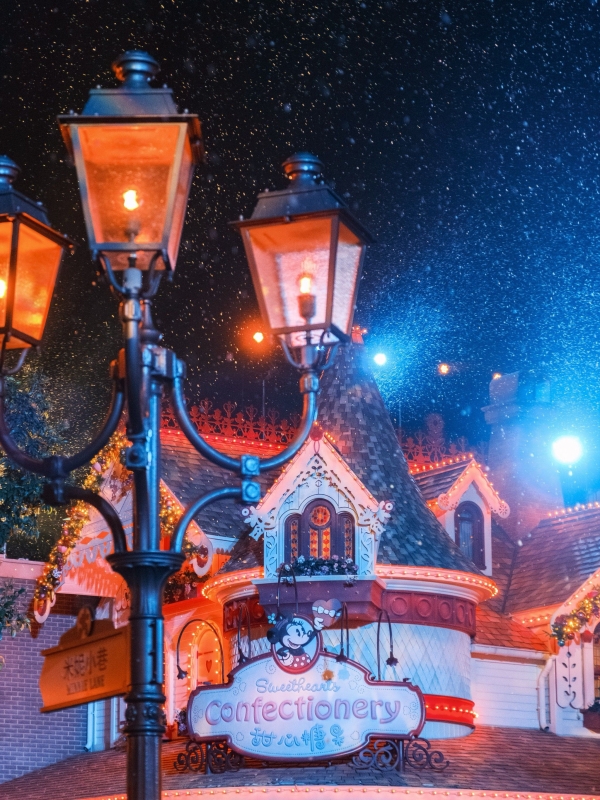At sunset, Shanghai’s skyline takes on new energy. Neon signs flash, steam wafts and the side streets echo with the sizzle of skewers. In Shanghai, a night market is more than just food stalls: It’s the city’s soul lit up after dark. You smell grilled squid, hear laughter blending with street music and see colors flashing. Residents haggle over homemade wares, and tourists pursue new tastes and ancient customs. This cultural mix means that there is vitality in every part of the city. It’s is much more than a snack stop — it’s a cultural stage. For first‑time visitors or old China hands, Shanghai’s night markets offer both authenticity and surprise. So read on and tuck back, into this night market guide for a glimpse of where Shanghai really comes alive.
Food and Flavor: Taste Local Classics
- Sijing Night Market
- Little Shanghai Pedestrian Street
- Pengpu Xingfu Night Market
Sijing Night Market
This night market crams hundreds of stalls into smoky alleyways, sizzling grills and fragrant steam wafting through the air. Staples like Ji Dan Lao Zao (fried sweet-glutinous-rice) and Zeng Gao are strong, as are offerings such as spicy Bobo Chicken and grilled squid; long-standing skewer carts invariably have lines. Fluorescent lights blink, hawkers cry out and laughter rings through the air. One of the many night markets serving Shanghai, Sijing shines — it scores a 4.8 on Ctrip, with reviewers describing it as “brimming with life and snacks from all over the country.”
The vibe is raw and lively. Diners juggle bowls as they wander, or stagger down on low stools next to friends. Families with young children arrive, students gravitate to favorite stalls, and tourists meander by with cameras in hand. The food moves fast, too — it will be eaten quickly enough for you to try a few different dishes in one night, and the din of the crowd adds to the feeling that you’re in a mobile street feast.
Quick Info
📍 Location: Songjiang District, near Sijing Old Street
🕒 Hours: 5 PM – midnight
💰 Average cost: ¥40–60 per person
🚇 Transport: Metro Line 9, Sijing Station
💡 Tip: Arrive early for grilled squid before queues get long.
Zhoupu Night Market (Little Shanghai Pedestrian Street)
This night market is a fusion of Shanghai traditions and snacks from around China, for a noisy stew that makes it the most densely packed. Stalls offer Cantonese rice rolls, Northeastern grilled noodles, Thai milk tea, Taiwanese wheel cakes and grazing upon skewer after skewer into the distance. The smoky scent wafts down neon-lit alleys as vendors call out. Wheel cakes with fresh fillings and rice roll shops with over-the-top sauces draw raves from regulars. It is a parade of flavors, each stand vying for your attention with color and sound. Xiaoshanghai Pedestrian Street has a 4.1 rarity on Ctrip, with visitors describing it as “quaint and full of vitality and lots of delicious snacks at reasonable prices.”
It’s noisy but it’s happy there. Families meander, couples nibble and students slide along from stall to stall. Lots of them eat while they walk, with skewers or tea in hand. The food comes quickly, so it’s easy to try a number of dishes in one evening. Here is where the fun lies in this mix of classics and creative twists, a street turned open-air college dining hall where discovery never really stops.
Quick Info
📍 Location: Pudong District, Zhoupu Pedestrian Street
🕒 Hours: 5 PM – 11 PM
💰 Average cost: ¥40–70 per person
🚇 Transport: Metro Line 16, Zhoupu Station
💡 Tip: Try the wheel cakes fresh out of the griddle for best taste.
Pengpu Xingfu Night Market
That market holds a decades-long reputation for Pengpu, now flowering with classic and modern flavors. Stalls line the alleys, where you can slurp spicy seafood bowls, gnaw Quzhou duck heads, gobble egg bubble waffles and chew on Southeast Asian pork ribs. Smoke wafts while vendors shout, echoing sound and scent through the lanes. Neighborhoods praise bubble waffles for their sweet smell, and the seafood corners snatch those wanting a taste that is bold. Ctrip users and reviewers speak about Pengpu Xingfu Night Market as a “foodie paradise,” with snacks from throughout China in an attractive, lively and tidy setting.
The crowd is lively and hot. Friends chat, skewers in hand; families congregate around plastic tables; tourists partake of snacks that are rarely spotted elsewhere. And tradition mixes with the avant-garde, providing comforting and startling common ground. Each meal is like a food carnival, and on nights when the dining room is humming, with plates steaming and voices lively, it makes the night seem to stretch with joy.
Quick Info
📍 Location: Jing’an District, Pengpu Community area
🕒 Hours: 6 PM – midnight
💰 Average cost: ¥35–55 per person
🚇 Transport: Metro Line 1, Pengpu Xincun Station
💡 Tip: Don’t miss the bubble waffles; lines form quickly after 8 PM.
Besides Shanghai, want to check out Guangzhou’s night vibes too? Read 12 Best Night Markets in Guangzhou: Street Food and Souvenirs Full of Local Vibes
Cultural and Tourism Fusion: Experience Culture with Food
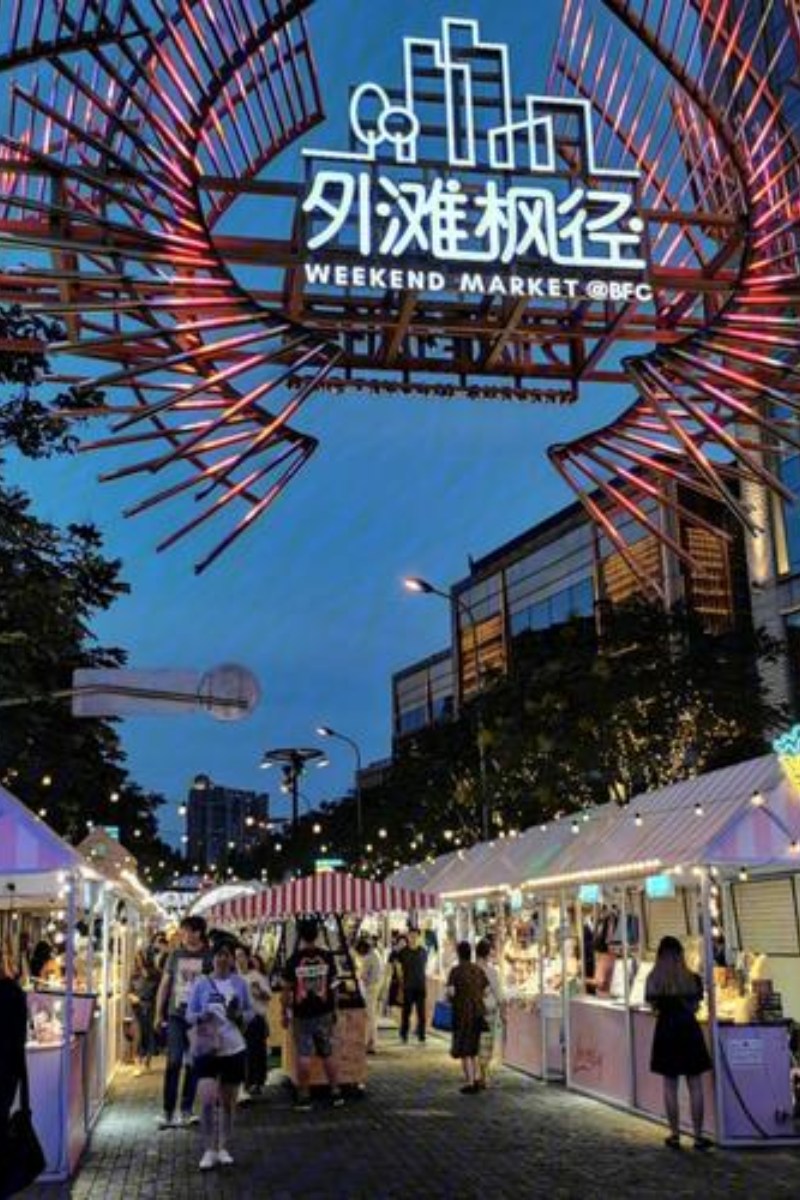
BFC Bund Fengjing Weekend Market
BFC Bund Fengjing Weekend Market
Running along a 360-meter street alongside the Bund, this riverside market is a little out of character. Stalls are a hodgepodge of Shanghai snacks alongside fusiony treats including wagyu skewers and craft bubble tea. Warm lights line the skyline, and performers in traditional costumes provide photo spots. Visitors can also rent hanfu for impromptu photo shoots against the backdrop of the Huangpu River. The pet zone is popular with families, but it’s the combination of food, fashion and natural beauty that makes it a lifestyle hub. On Ctrip, Fengjing Night Market has a 4.5/5 rating and past visitors love its variety of food, skyline view and fun vibe.
The shopping isn’t food-only, with Bund postcards and enamel pins and tea sets on offer. An artisan sells jewelry inspired by old Shanghai, while small workshops invite guests to try sugar painting or leather stamping. Couples stroll with cocktails or dessert towers, and jazz wafts from down the street. The street feels lighthearted and elegant, a cultural festival that has everyone clicking photos and creating memories.
Quick Info
📍 Location: Huangpu District, near the Bund
🕓 Hours: 5 PM – 11 PM (weekends & holidays)
💰 Average cost: ¥50–80 per person
🚇 Transport: Metro Line 10, Yuyuan Garden Station
💡 Tip: Arrive before sunset to catch skyline photos while tasting snacks.
Yuyuan Bazaar Night Market
This night market curls around Yu Garden and seems like a cultural performance stage. Red lanterns shimmer beneath carved eaves, and the scent of Nanxiang soup dumplings wafts into rickety lanes. Visitors nibble on pear syrup candy or sip herbal teas as they peruse craft stands with shadow puppets and woodblock prints. The lanes reverberate with the sound of Suzhou opera and folk tales, rendering the entire bazaar a living scene from China’s cultural heritage.
Between snacks and shows, the market offers hands-on fun. You could make clay figurines, cut paper patterns or practice calligraphy on fans. Silk scarves with dragon patterns and lotus cups of porcelain are among the things one can buy. The evening light show across tiled rooftops is the highlight, with families standing in front to watch as they pass by puppet theaters at which others stop or queuing for cultural merch. Yuyuan’s bazaar commingles dining, shopping and tradition, transforming a leisurely stroll into an encounter with history.
Quick Info
📍 Location: Huangpu District, Yu Garden core area
🕓 Hours: 6 PM – 11 PM
💰 Average cost: ¥40–70 per person
🚇 Transport: Metro Line 10, Yuyuan Garden Station
💡 Tip: Don’t miss the evening lantern show; it starts around 7:30 PM.
Qibao Old Town Night Market
Within Qibao Ancient Town, stone‑gate alleys turn into a flourishing night market. Vendors hawk tangyuan studded with sesame, braised pork cinched with straw and spicy skewers from other provinces. The hiss of woks frying blends with Pingtan singing in the air, and visitors idle under arches illuminated by warm lantern light. Hanfu rental and bridge selfies catch on with younger tourists. Downtown, locals share tales of Qibao’s history: Food laced with memory. And the vibe is more supportive of meandering than manic sprinting, which is great for families.
The shopping side is equally delightful. Sachets made by hand with herbs, embroidered coin purses and bamboo toys stretch the length of stalls. Some craft workers carve seals or paint name charms, drawing foreign tourists. Cultural IP souvenirs such as keychains designed in the shape of — what do you know — Qibao bridges, are snapped up as keepsakes. Schoolchildren adore lollipops yanked hot from sugar molds; adults drink rice wine from clay cups. The ambience links antiquated streets to contemporary cravings. Walking there fills both stomach and wish for something you can hold in your hands, culture-wise.
Quick Info
📍 Location: Minhang District, Qibao Ancient Town
🕓 Hours: 5:30 PM – 10:30 PM
💰 Average cost: ¥30–60 per person
🚇 Transport: Metro Line 9, Qibao Station
💡 Tip: Best to visit on weekdays to avoid weekend crowds.
Artsy and Trendy: Discover Youthful Trends
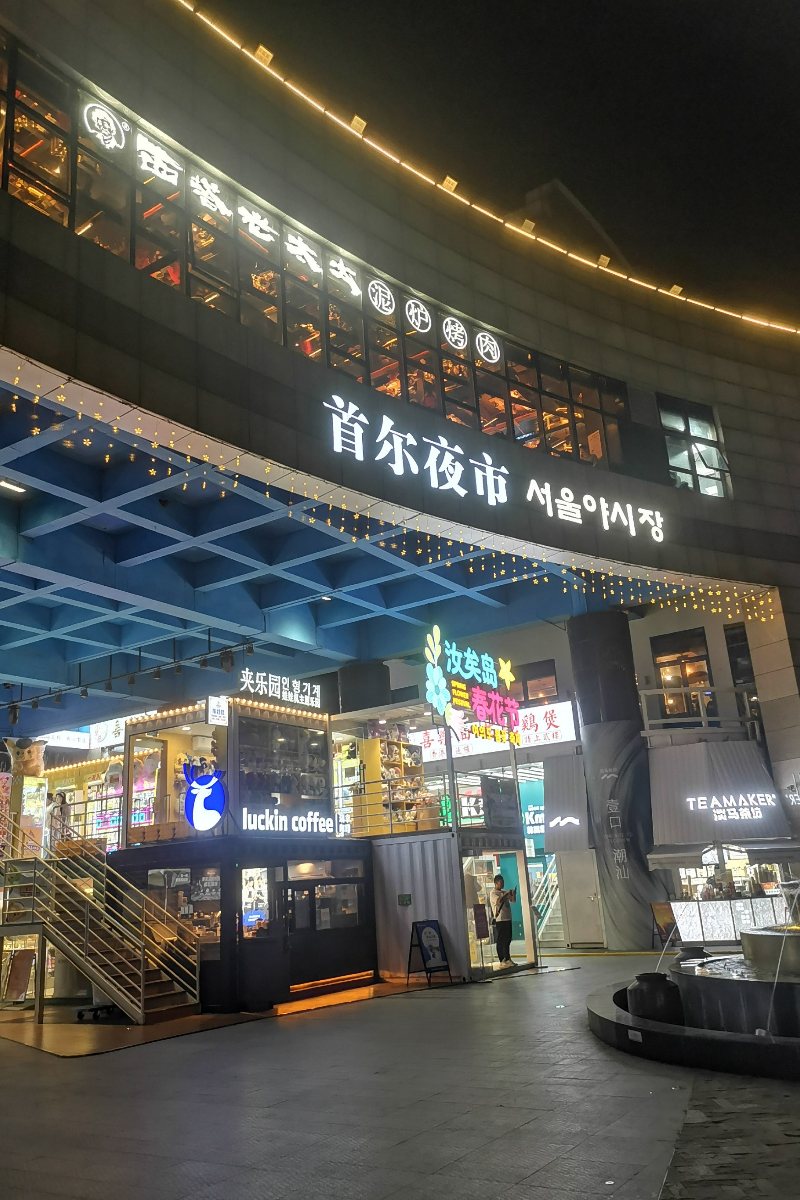
Seoul Night Market
Turing Market
As I walked into Turing Market, and distance on one side kids were running toward some anime booths. Neon-lighted pathways were bordered by booths selling handmade toys, blind boxes and quirky jewelry. Local bands played indie music, and a graffiti artist painted on one nearby wall. You might get a matcha latte or fruit beer in your hand, then toss down by the lake with friends. The medley of IP events — soccer mascots, anime screenings — gave it a festival atmosphere. I felt as if everyone around me shopped and put on their style.
I later learned how to “hack” by attending a DIY corner where people were personalizing resin phone cases by smearing cream glue and stickers on them. Next to me, flocks of students chuckled while playing arcade-style dart games. Couples passed small plates of Korean fried chicken and macarons, while others exchanged tarot readings. I realized that this place wasn’t really about buying things — it was more about showing who you were. I’d suggest it if you fancy a night that’s half gallery, half playground.
Quick Info
📍 Location: Pudong New Area, Dishui Lake
⏰ Hours: Friday–Sunday, 5:00 PM – 10:00 PM (seasonal)
💰 Average cost: ¥40–80 per person
🚇 Transport: Metro Line 16, Dishui Lake Station
💡 Tip: Perfect for families and anime lovers; visit at sunset for lake views.
Seoul Night Market
I could smell the sizzling bulgogi skewers wafting in the air even before I made my way to the main gate. This Korean-style night market combines traditional food vendors with fashionable design shops. Luminous tents were splashed with light, and K-pop remixes filled the air. You had people lining up for kimchi pancakes, craft beer and Korean skincare pop-ups. It was like walking into a Seoul street corner with Shanghai’s energy running through every lane.
Further in, I also spotted tarot readers, claw machines and a little stage that dancers used to run street routines. Some friends dragged me into a container bar where they made fruit soju cocktails. It was all one jumbled mashup of flavors, music and social sparks. The mood was unhurried — attendees dawdled, chatted and made plans for next weekend’s festival. If you are fan of food served with a side of nightlife, then this is a place that keeps on giving.
Quick Info
📍 Location: Minhang District, 1078 Hongquan Road
⏰ Hours: 5:30 PM – 10:30 PM
💰 Average cost: ¥30–60 per person
🚇 Transport: Metro Line 10, Longbai Xincun Station
💡 Tip: Go on weekdays to avoid weekend crowds; best during music festivals.
Danxia Street Market
It was Danxia Street Market, and the container-based design painted in striking colors caught my eye. Every stall had its vibe: here, a swath of vintage jackets; there, handmade silver rings; over yon way, Japanese mochi ice cream. Local DJs played electronic tracks, and crowds gathered around a graffiti wall where artists sprayed paint in real time. It was less a place you could browse quietly, more where you’d jump into a shared vibe of energy.
I made my way over to a coffee stand that sold intricate lattes with rainbow hued foam. Nearby, friends in camping chairs sipped fruit wine as they sketched designs for T-shirts that they had just bought from a designer pop-up. Art installations scattered throughout provided everyone ample fodder to snap pictures and share online. I liked that it wasn’t just being about consumption, but about expression. It’s a social playground, and you stick around longer than you had intended.
Quick Info
📍 Location: Baoshan District, Longfor Paradise Walk
⏰ Hours: 5:00 PM – 10:00 PM, weekends
💰 Average cost: ¥50–90 per person
🚇 Transport: Metro Line 1, Gongkang Road Station
💡 Tip: Arrive early for best photo spots and art shows.
Already explored night markets, but want more fashion finds? Discover Top 12 Spots of Shanghai Clothing Stores to Buy (Perfect Gifts for 2025)
Convenient Life: Meet Daily Needs
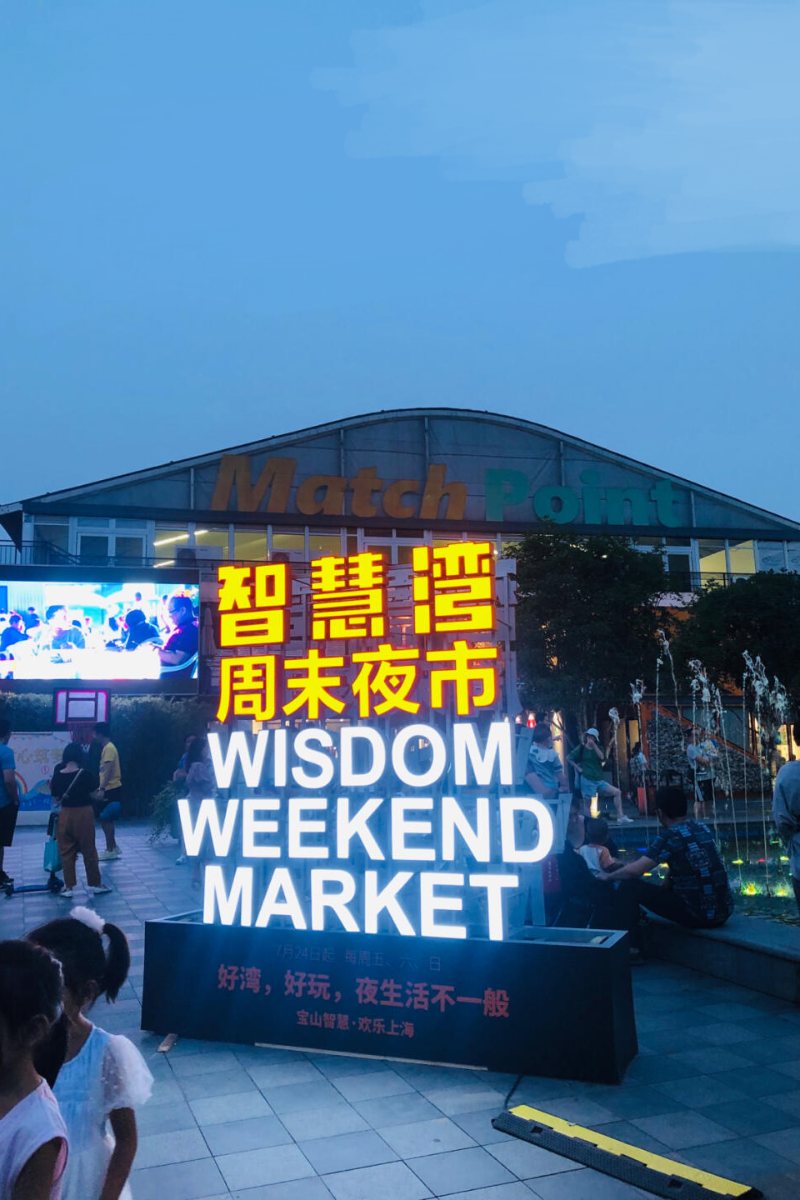
Wisdom Bay Night Market
Dongchang Road Night Market
Dongchang Road Night Market, near the Bund in Huangpu District. The market feels straightforward and utilitarian, with stalls arranged in straight lines. Traders offer, at friendly prices, fresh vegetables, fruits and snacks. Dumplings, steamed buns and a bowl of noodles prove to be popular fare that many residents pick up after work. The place isn’t pretty, but it’s easy — plus you’re sure to catch a local haggling with sellers for a better deal.
Another aspect here is the composition of daily goods. Socks, kitchen tools or seasonal scarves may be down the way from food sellers. A few vendors also offer small services, such as shoe repair or phone screen protectors. It’s a place where families go on weekend nights, with parents shopping and kids having skewers or sweet tofu pudding. The market closes earlier than downtown spots, typically by 9 p.m., so it slots nicely into the community rhythm of life.
Quick Info
📍 Location: Huangpu District, near the Bund
🕔 Hours: 5:00 PM – 9:00 PM, daily
💰 Average cost: ¥30–70 per person
🚇 Transport: Metro Line 4, Dongjiadu Station
💡 Tip: Bargain with vendors for better deals.
Looking for top bars in Guangzhou? Read the Bars in Guangzhou Travel Guide.
Wisdom Bay Night Market
Baoshan’s Wisdom Bay Night Market is enormous and yet it maintains earthy appeal. The design includes clothing, electronics and household goods. But the pièce de résistance for many is the fresh food section where seafood stalls and fruit stands have been drawing long lines. Locals shop here for dinner as well as the week’s groceries. The scale helps compare prices and find affordable options.
Among goods, you also encounter practical service strewn between the aisles. One stall fixes watches, another assists with sewing garments, and the food stalls sell porridge or fried dumplings. The scent of grilled squid and steamed buns wafts through the night air. Friends roam in groups, sharing snacks they’ve just bought or kicking a hacky sack between them as two elderly shoppers concentrate on produce and fresh fish. It combines the convenience and variety that make it a regular stop for neighboring communities.
Quick Info
📍 Location: Baoshan District, Longfor Paradise Walk
🕔 Hours: 5:00 PM – 10:00 PM, weekends
💰 Average cost: ¥50–90 per person
🚇 Transport: Metro Line 1, Gongkang Road Station
💡 Tip: Arrive early for best photo spots and art shows.
Xujiahui Electronics Night Market
Xujiahui Electronics Night Market is known for gadgets and accessories. Small boats hawk phone cases, chargers and earphones for next to nothing. Students stream through after class looking for cheap electronics or minor repairs. The area may not be polished, but it gets the job done for expedient solutions and everyday necessities.
The meals available make this place very homely. The stalls serve cheap noodles, buns and soy milk, drawing in office workers seeking late-night snacks. A few customers sip tea and share dumplings with friends, while they wait for repairs on their devices. The market is open until evening but closes slightly earlier than heavily touristed sections. It is a local corner where function trumps style, and that’s what makes it a community fixture you can rely on.
Quick Info
📍 Location: Xuhui District, near Xujiahui Station
🕔 Hours: 5:30 PM – 9:30 PM, daily
💰 Average cost: ¥40–80 per person
🚇 Transport: Metro Line 1 & 9, Xujiahui Station
💡 Tip: Great for quick gadget fixes and affordable eats.
Payment and Language
If you are new in China, Alipay and WeChat Pay will change your life. 1 Foreigners can sign up with a passport and enter an offshore bank card (visa, master, JCB). Just be sure your phone’s data is on because every snack stall and metro gate runs on QR codes. However, maintaining a modest cache of cash is handy for when you’re at a terminal that bites the dust.
A couple of phrases smooth things out when you are ordering food or asking for help:
点餐: “Diǎn cān” (I’d like to order food)
多少钱: “Duō shǎo qián?” (How much is it?)
厕所在哪: “Cè suǒ zài nǎ?” (Where’s the restroom?)
去…怎么走: “Qù … zěn me zǒu?” (How do I get to…?)
Locals appreciate the effort, even if your accent is rough. Often, just trying gets you a smile and faster service.
Need quick tips for paying like a local on your trip? Visit How Do Foreigners Pay in China: Your Cashless Survival Guide 2025
Transportation and Timing
Shanghai metro is the spine of the city, inexpensive and super reliable. Most lines operate between 5:30 am and 11:00 pm, though night markets typically remain busy until after 10 pm. In other words, eat your last bit of grilled squid or bubble tea on time: 10:30 p.m., lest you encounter a monster taxi queue, or worse yet, a ruinously expensive Didi ride.
Visiting the big markets such as Yuyuan Night Market or Shouning Road, check your closest metro station closing times. Some stops shut down before official last train. A quick check on the MetroMan or Baidu Maps app will prevent you from sprinting down escalators in a frenzy.
Safety and Hygiene
Crowds mean pickpockets. Keep your phone in your front pocket or a zipped crossbody bag. Don’t pull out large wads of cash when you pay, and if you do have any, break it into several smaller piles. The night markets are for the most part safe, but pickpockets do well in crowded areas.
For the sake of hygiene, tote tissues or wet wipes — public restrooms sometimes won’t offer them. People also steer clear of raw or undercooked street food when it gets late at night, particularly seafood. Hot skewers or fried dumplings are probably safer after midnight. A tiny bottle of hand sanitizer will protect you from sticky sauces, packed handrails and surprise messes so your night stays smooth.
FAQs: Answer Common Visitor Questions
Q: Are there Shanghai night markets all year round?
A: The markets are open most of the year, and outdoor vendors often reduce hours when it is cold. Even during summer evenings the lanes are still busy with families, students and tourists. Holidays equal additional crowds, so anticipate long lines for any popular snacks. Winter nights may be quieter, but warm dishes like hotpot skewers occupy the soundscape. A trip to a night market in Shanghai during any season demonstrates how the city transforms after hours.
Q: Will I have to know Chinese in order to buy food?
A: Even if your Chinese is rudimentary, you can order from many vendors using picture menus. Pointing is fine, a word like “zhège” doesn’t hurt. The smiles help as well, and vendors tend to answer charitably. If you have a translation app, it comes in handy if someone has any special requests or allergies. In Shanghai, sign language and friendliness make it easier to order at a night market.
Q: Do night markets usually involve haggling?
A: When it comes to souvenirs, daily goods and non-food items bargaining is acceptable. They are expecting it, so counter politely and in friendly tone. (As the price tables indicate, food stalls are more likely to have fixed prices; haggling there can feel awkward.) Consider haggling as a game instead of a hard-and-fast rule. Haggling at a night market in Shanghai can make shopping more fun.
Q: Which are the best night markets for families with kids?
A: Yuyuan Bazaar draws families to its performances, lanterns and well-lighted foot lanes. At Turing Market, Ikanimarket’s sister market, there are fair games and handicraft and anime stalls for kids. Both places combine food with culture, forging activities beyond eating. And parents have access to nearby seating, which means they can more easily rest between snacks. A night market in Shanghai has the rare feeling of being both a safe and fun place for families to hang out together.
Q: Can foreigners pay for meals at stalls with a credit card?
A: Nearly everywhere takes a physical credit card, using QR codes is the exception. Foreign visitors connect international cards to Alipay or WeChat Pay for added convenience. Have some small money for use in case you lose your phone signal. Larger markets have shopping malls nearby that accept cards, but not individual stalls. QR-standards are the best way to pay at a night market in Shanghai.
Q: Are vegetarian options available?
A: We have vegetarian food, such as fried noodles, dumplings with vegetables and skewers of tofu. Savory dainties like wheel cakes, rice rolls and sweet desserts also suit meat-free diets. This type of vegan have to be careful though, because the sauces could contain animal products. Chatting with vendors can also help clear up what’s inside. At a night market in Shanghai, vegetarian travelers have plenty of options.
Q: How much does a night market meal usually cost?
A: Most markets have points where you can get a filling meal for about ¥40–70 per person. People-watching areas, like the Bund, charge extra for premium dishes. Locals suggest adding a side of cheap skewers to one specialty dish for balance. Families typically spend a little more in ordering drinks and desserts. Budgeting for a night market in Shanghai means you try lots of snacks.
Q: Is it OK to experiment with seafood late at night?
A: The fish is really at its freshest earlier in the evening when there’s a higher volume of turnover. And in the event that freshness could fail withering gastric risk, after midnight. Natives tend to prefer grilled or fried seafood rather than raw. Optimal food is often located at busy stands with long lines. To eat seafood at a night market in Shanghai, buy early and from vendors with lots of customers (it’s safest).
Q: When does public transit shut down near markets?
A: Most subway lines will run until around 11 p.m., but some cease service earlier. Be sure to check the last train times in apps like MetroMan or Baidu Maps. If you do miss the metro, Didi and taxis are reliable. Good planning prevents long lines and late-night price hikes. If you follow metro hours, a night market in Shanghai is much easier to savor.
Q: What’s the best market for souvenirs?
A: Crafts like silk scarves, puppets and porcelain cups are sold in Yuyuan Bazaar. Sachets, carved seals and handmade trinkets can be found at Qibao Old Town. Both are inhabited by collectors hungry for items associated with cultural heritage. Bartering is usually successful for souvenirs and elevates your shopping experience. Keepsakes from a night market in Shanghai are souvenir shopping to bring home with you.
